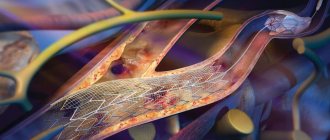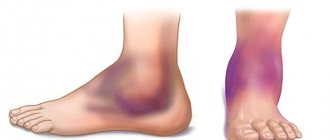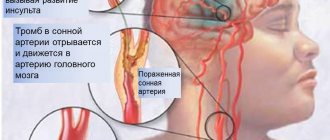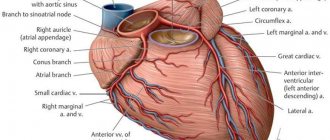Stenosing atherosclerosis MAG - what is it?
Stenotic atherosclerosis is a pathology of blood vessels. Fatty deposits, called cholesterol plaques, form on the inner walls of these vessels.
What is important is that the disease is not sudden. Its development occurs over a long period of time, with the slow formation of plaques.
There is a process with the formation of calcifications and the gradual proliferation of connective tissues. The mechanism of occurrence and spread of the disease in the body comes down to the accumulation of low-density fats in the blood. Over time, they stick to the slightest irregularities inside the vessels and form plaques, which, as the disease progresses, lead to blockage of the arteries. As a result, the clearance for blood flow decreases to such an extent that the blood supply is completely disrupted, leading to ischemia of organs and tissues.
Causes and risk factors
The main cause of stenosing atherosclerosis is age-related changes occurring in the body.
The most obvious causes of the disease include:
- Hypertension.
- Diabetes.
- Genetic predisposition.
- Obesity (any degree of severity).
- Gender (men are more susceptible to developing stenotic atherosclerosis).
- Poor nutrition, consumption of large amounts of unhealthy, cholesterol-rich foods.
- Physical inactivity.
It is also important to keep in mind the existence of certain risk factors:
- Bad habits (smoking, drinking large amounts of alcohol).
- Nervous overload, constant state of anxiety, stress.
Reference! The disease can manifest itself in various parts of the body, but the lower extremities are most susceptible to negative changes as a result of the development of the disease.
To a large extent, this process is influenced by a person’s lifestyle and the conditions in which he works. The most obvious provocateurs of stenosing atherosclerosis of the lower extremities are considered to be injuries and severe hypothermia.
Causes of the disease
The reasons leading to the formation of lipid deposits in any main arteries are the same.
Regardless of where the atherosclerotic plaque was localized, its growth was provoked by the following factors:
- High blood pressure that is not controlled and treated over a long period of time;
- Adherence to bad habits, in particular smoking;
- Blood cholesterol levels exceeding normal levels;
- Excess body weight;
- Diseases of the endocrine system;
- Impaired absorption of glucose;
- Sedentary lifestyle;
- Errors in nutrition;
- Age-related changes, which are an irremovable provoking factor;
- Frequent stress.
Varieties and its manifestations
There are several types of stenosing atherosclerosis:
Stenosing atherosclerosis of the main arteries of the head (MAG). One of the most serious types of stenosing atherosclerosis in its manifestation, since it can cause the development of brain failure. The manifestation of atherosclerosis MAG can be divided into 3 groups of symptoms.- The first (general cerebral symptoms) include: memory impairment, headaches, decreased brain activity.
- The second (manifestations of an ocular nature): attacks of sudden deterioration of vision or partial blindness.
- And finally, to the third (hemispheric symptoms): facial asymmetry, speech impairment, pain during movement.
Stenosing atherosclerosis of the brachiocephalic arteries (BCA). With the development of this type of disease, the following is observed:- dizziness;
- constant heavy snoring;
- bad feeling;
- pressure surges, etc.
Stenosing atherosclerosis of cerebral arteries. Manifests itself predominantly in a number of neurological symptoms:- headache;
- memory impairment;
- organic vision lesions (in some cases);
- impaired speech clarity and many other unpleasant symptoms of the disease.
Stenosing atherosclerosis of the lower extremities. In the initial stages, there is a feeling of chilliness and tingling in the legs, numbness in some areas of the foot. As the disease progresses, lameness begins to clearly appear, eventually becoming pronounced. In the final stages of development of the disease, the feet swell, atrophic ulcers appear on them, which subsequently leads to the occurrence of gangrene.
Symptoms of atherosclerosis of the great arteries
Depending on which main arteries have been damaged by atherosclerosis, the symptoms of the disease will vary.
If we are talking about damage to the artery of the brain, then the person will experience:
- Attacks of headaches and dizziness of varying intensity;
- Noises in the ears;
- Difficulty falling asleep, waking up in the middle of the night, feeling drowsy during the daytime due to general fatigue;
- Decreased short-term memory;
- Changes in character traits, the appearance of tearfulness, increased levels of anxiety, excessive suspicion and emotional lability;
- Gait and speech disorders, as well as other neurological disorders.
When atherosclerosis affects the main arteries of the upper and lower extremities, it will manifest itself as follows:
- When the arteries of the lower extremities are affected, a person most often suffers from intermittent claudication;
- The feeling of fatigue from walking comes much earlier; walking a long section of the path becomes a labor-intensive task;
- There is degeneration of the nail plates, hair loss on the legs, and a decrease in the size of the calf muscles.
- Gangrene of the limbs is the apogee of the development of the disease;
- Reduced pulsation in the arteries;
- If the arteries of the upper extremities are primarily affected, then the person’s hands feel cold, ulcers may form, and small wounds will bleed for a long time.
Diagnosis of the disease
A number of medical devices and procedures are used to diagnose the disease:
- Initially, the doctor collects an anamnesis of the disease, asks the patient about his lifestyle and habits, and then begins a visual examination.
- After receiving the initial data, the patient must undergo a series of tests (general, biochemical and immunological blood tests, urine analysis - to identify a possible inflammatory focus).
- The specialist does an ECG and ultrasound of the heart, MRI.
Important! Ultrasound signs are considered the most accurate confirmation of an unpleasant diagnosis. The Doppler picture is based on signals from an ultrasound machine, which are received during the procedure by reflection from blood elements. - If a questionable result is obtained, the doctor additionally prescribes angiography to determine the level of blood flow in the vessels.
- Echocardiography makes it possible to determine the presence of damage to the heart vessels, and stress echocardiography allows not only to detect the presence of significant atherosclerosis, but also to determine its location.
- If necessary, the doctor consults with other specialists depending on the area affected by stenosing atherosclerosis.
Diagnostics
Diagnosis of pathology includes:
- Inspection. At the appointment, the specialist finds out the patient’s complaints and risk factors for his disease. On a general examination, various atherosclerotic lesions are identified.
- Laboratory research. Before treatment, the patient must take a blood test, which allows you to study the level of cholesterol, triglycerides and lipoproteins.
- Angiography. This study evaluates blood flow disorders.
- Aortography. This examination is carried out to detect elongation of the aorta and its thickening, calcification, expansion in the thoracic or abdominal regions, and aneurysms.
- Coronary angiography. This examination is effective for assessing the condition of the coronary system.
Other modern techniques are also used for diagnosis. They allow not only to make an accurate diagnosis, but also to predict the development of pathology, assess the patient’s condition, select the right medications, and adjust their dosage during therapy.
Treatment methods
If you identify symptoms of the disease, you should first contact a therapist, who will refute or confirm the diagnosis and refer you to the right specialist.
For example, stenosing atherosclerosis of the MAG/vessels of the lower extremities is treated by an angiologist, atherosclerosis of the cerebral arteries, BCA - by a neurologist. To treat the disease, it is better to give preference to a conservative approach. It includes forming a strict diet and taking special medications aimed at inhibiting the destructive effects of the disease.
The essence of the therapeutic diet is to eliminate from the diet foods rich in cholesterol and animal fats (fast food, sweets, fatty meats, fatty dairy products, offal, etc.). But the amount of foods containing vitamin E and antioxidants, on the contrary, should be increased. The diet also includes eating plenty of fruits and vegetables (without any restrictions).
Attention! A good effect can be achieved by limiting salt intake, since this product tends to delay the removal of fluid from the body, which, in case of circulatory problems, can be fraught with a persistent increase in pressure (additional load on the walls of blood vessels).
If the diet does not give the desired results, over time you have to resort to a number of medications that can correct the lipid profile.
Drugs used for treatment:
- Inhibitors (Sinopril, Lisinopril). Absorb cholesterol, preventing its absorption into the blood.
- Statins (Atoris, Zator). They reduce the body's production of cholesterol and accelerate the removal of fats and similar substances from the body.
- Fibrates (Gemfibrozil, Tycolor). They increase the density of lipoproteins, whose task is to protect the walls of blood vessels from cholesterol.
- Sequestrants (cholestipol, cholestyramine). Effectively and quickly remove cholesterol from the body.
For the treatment of atherosclerosis of the main arteries of the head with stenosis, blood pressure stabilizers (qualitatively reduce the load on the vascular system) and anticoagulants (thin the blood, facilitating its movement even through stenotic arteries “clogged” with cholesterol plaques) are also prescribed.
Atherosclerosis of cerebral vessels
Atherosclerosis is the most common chronic disease that affects blood vessels, in particular, elastic and elastic-muscular arteries of the heart, brain and other organs with the formation on their inner surface of fatty, often cholesterol deposits in the form of atheromatous (from the Latin “atero” - porridge ) plaques with subsequent growth of dense connective tissue in them (sclerosation) and impregnation with calcium salts (liming).
As a result, the lumen of the arteries gradually decreases or becomes obliterated, i.e. disappears completely, which leads to increasing insufficiency of blood supply to the organ tissues supplied by this artery. In addition, complete blockages (occlusions) of the lumen of blood vessels are possible with the contents of plaques in combination with blood clots, which leads to tissue necrosis (infarction) or gangrene of an organ or part of the body.
The studies conducted indicate the possibility of complete resorption of cholesterol infiltration of blood vessels, which indicates the possibility of curing atherosclerosis in the early stages of its development. The appearance of atherosclerotic plaques
sometimes they are found in young people at the age of 20, but the greatest prevalence of the disease is observed in people of mature age - 50-60 years, and more often in men; In women, the disease is more common after 60 years of age. The high prevalence of this disease among the population associates it even with one of the manifestations of aging of the body
"Personal health plan"
is a comprehensive examination based on evidence-based recommendations
Causes of cerebral atherosclerosis
Among the causes of the disease, along with hereditary predisposition, one should note frequently recurring psycho-emotional stress that affects the tone of the arteries, hypertension, diabetes mellitus, obesity, physical inactivity and smoking.
Clinical manifestation of cerebral atherosclerosis
is determined by the degree of insufficiency (ischemia) of blood circulation and nutrition of brain tissue caused by it. The first signs of ischemia include periodic headaches and transient tinnitus, especially during periods of intense mental activity. There is a deterioration in memory for current events, forgetting words during a conversation, but memory for long-past events is completely preserved. Sleep is disturbed, disturbing awakenings and insomnia become frequent. Patients experience changes in the psycho-emotional sphere - they become suspicious, prone to tearfulness, causeless depression and “mental chewing gum” - prolonged experience of minor failures or grievances.
Subsequently, patients exhibit more objective manifestations of cerebral atherosclerosis
– impaired coordination of movements, periodic, especially with excitement, trembling of the limbs and head. When examining the large arteries of the brain, signs of their calcification can be determined, and pulsation of the brachial arteries also becomes visible. During this period, due to temporary cerebral ischemia, patients may develop transient (transient) strokes with temporary disturbances of skin sensitivity - paresthesia, skeletal and facial muscle tone with weakening of active movements in individual limbs, unilateral facial distortion due to loss of muscle tone. The most serious complication of the disease is ischemic stroke of a part of the brain due to complete occlusion of one of the large cerebral arteries, which, as a rule, leads to permanent disability of the patient.
ONLINE CONSULTATIONS
We treat where it is convenient for you
MORE DETAILS
Treatment of cerebral atherosclerosis
In treating a patient, the main task of the doctor is to prevent further progression of the formation of atherosclerotic plaques and stimulate the development of roundabout circulatory pathways in the suffering organs. The latter is achieved by prescribing individual physical therapy in the form of dosed and regular physical activity appropriate to the age and capabilities of the patient. This measure promotes the opening of the collateral network of vessels that is not involved at rest and in conditions of habitual physical inactivity, bringing blood to the organ suffering from ischemia. In combination with physical exercise, walks in the fresh air, light body massage, water procedures, including balneotherapy with therapeutic iodine-bromine, radon baths or using pine extract, sea salt, and oat decoction will be useful. These procedures also help reduce the excitability of the nervous system and normalize blood pressure.
Measures aimed at preventing the progression of atherosclerosis primarily include a balanced diet with a limited and equal content of vegetable and animal fats, a sufficient content of vitamins (primarily vitamin C, antioxidants - vitamins E, A, as well as B vitamins) and eliminating weight gain. The daily diet should be dominated by plant foods - greens, fruits, vegetables, fish and seafood; white breads, pasta, foods high in cholesterol - fatty meats, smoked meats, eggs and butter should be limited. In case of excess weight, nutrition should be aimed at reducing it by limiting the caloric content of food. The removal of excess cholesterol from the body is facilitated by measures to cleanse it, in particular by cleansing the intestines of cholesterol associated with bile, by periodically taking saline laxatives, including cereals rich in plant fiber in food, and repeated intestinal irrigation.
When treating concomitant diseases that contribute to the development and progression of the process (primarily hypertension and diabetes mellitus), one should not strive to urgently reduce blood sugar levels and blood pressure - this can aggravate existing organ ischemia. But at the same time, systematic treatment of these diseases is also one of the main measures of secondary prevention.
Drug treatment under medical supervision with drugs that lower blood cholesterol levels can only play a secondary role in this case.
Consequences and complications
Late detection of the disease and lack of proper treatment can lead to irreversible and very serious consequences. For example, damage to the carotid arteries can provoke a stroke, and severe blockage of the main arteries of the head can lead to massive hemorrhages. There are a number of complications provoked by the rapid progression of the disease:
Spicy. The development of the disease can lead to serious disorders of cerebral and cardiac circulation (aortic aneurysm, gangrene, ischemia of the heart muscle, etc.).- Chronic. Insufficient blood circulation in the diseased parts of the body leads over time to functional and then organic (unfortunately, irreversible) changes. So, if atherosclerosis of the BCA was detected untimely or treatment was not prescribed on time, the patient will eventually develop a neurological disorder in the brain. Dementia often develops on this basis.
Preventive measures
To prevent the development of the disease and the manifestation of its complications, it is necessary to strictly follow the doctor’s instructions. The following tips should be followed to prevent illness:
- Strict control over blood pressure.
- Carrying out regular (moderate) physical activity (fitness, yoga, swimming, running, walking in the fresh air, etc.).
- Refusal of bad habits (if any are present in life).
- A balanced, healthy diet rich in antioxidants and vitamins.
- Regular preventive examinations by a specialist.
How effective is treatment of the disease with folk remedies (herbs), read here; and how to deal with the disease - follow the link.
Treatment
A number of techniques are used to treat non-stenotic atherosclerosis. The patient must always adhere to all doctor's recommendations. Only in this case will he be able to prolong the period of active life and avoid negative consequences (complete blockage of blood vessels, strokes and death).
To prescribe optimal therapy for non-stenotic atherosclerosis, the doctor:
- Determines the stage of the disease.
- Records general symptoms.
All medications are prescribed individually and take into account the patient’s condition.
As a rule, patients take:
- Anticoagulants. This reduces the risk of blood clots and strokes.
- Medicines to lower blood pressure (if it increases). Such remedies can reduce the load on the arteries, dilate blood vessels, improve blood flow and relieve spasms.
- Medicines to lower cholesterol levels. Typically, such drugs are taken throughout life after atherosclerosis of the brachiocephalic arteries is detected.
It is also very important to constantly monitor the patient's lipid balance. If necessary, sedatives are prescribed. They allow you to normalize the emotional background, avoid depression, improve the quality of sleep, and get rid of headaches. Patients are often prescribed physiotherapy.
The decision to undergo surgical intervention is usually made if the passages are significantly narrowed and the disease has reached a high stage of development.
The following types of operations are carried out today:
- Removing part of the artery and replacing it with a prosthesis.
- Stitching a vessel to reduce its size.
Endovascular operations are increasingly being performed. They are as safe as possible, and recovery from them takes a short period of time.
Are you interested in all the features of therapy? Contact our specialists. You will not have to overpay for a consultation. Prices are indicated on the website. Note! The cost is approximate. The exact price of therapy will be announced by your attending physician. In any case, you will not overpay. Our private clinic in Moscow adheres to a loyal pricing policy.










